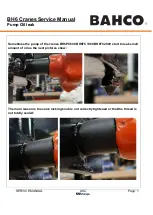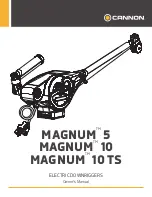
6 - WORKING OPERATIONS
Grains:
Grains tend not to fill the bag to the top of the tunnel, regardless of anchor pressure. Regulate anchor pressure by
measuring your stretch bars approximately 30 feet back from the bagger. Keep the stretch indicators within the bag
manufacturer’s specifications.
Product Moisture
Refer to the “3M’s of Silage” supplement available from your Miller Ag-Bag dealer for more detailed information on
product moisture levels. Moisture levels play an important part of product quality.
Dry Product:
Dry product makes a lumpy bag. Long dry chop is hard on the bagger. Remember when trying to make good haylage,
dry feeds have more resistance. They will pack higher in the bag and less anchor pressure is required.
Wet Product:
Moisture levels above 70% may create excessive liquid in the bag. This excessive liquid is OK unless the bag is
outside the recommended shape. Slowly release anchor pressure until the bag is within the recommended shape.
Let the product wilt longer in the field if liquid does not dissipate. Wet product does not rise very high in the bag. The
result will be a wide bag.
Bag Location
Choose an area using the following recommendations:
• Remove rocks and sticks from the site
• Good drainage of site is important
• Concrete, asphalt, gravel or packed limestone works well under bags
• Pick a site away from rodents
• Protect your site from livestock with fencing.
Bag installation
Enclosed in each box of bags is an instruction sheet with pictures to help you properly install the bag on your bagger.
Please take time to understand the best method of bag installation. The bag should be placed on the machine with
the bag logo in an area between 1 and 3 o’clock.
Watch the stretch indicators on the bag. The bag is overfilled when the stretch indicator exceeds the manufacturer’s
recommendations.
Correcting Bag Stretch
Ground To Ground Method:
1. Tie weights (hex nuts) approximately
113 g
(
4 oz
) to
one end of a string and one weight (hex nut) approx-
imately
57 g
(
2 oz
) to the opposite end of the string.
The distance between the nuts need to be
9.0 m
(
29.5 ft
) for a
14 ft
bag or
8.1 m
(
26.5 ft
) for the
12 ft
bag.
2. Straddle the string over the bag approximately
5 m
(
15 ft
) away from the bagger.
3. While bagging, when the single nut touches the
ground, increase the anchor pressure and/or brake
pressure. If the nut comes off the ground more than
8 cm
(
3 in
), reduce the anchor pressure and/or brake
pressure.
NOTE:
Use this procedure only as a visual aid. Remem-
ber, measuring the stretch bars on the bag and maintain-
ing appropriate stretch dimension is important. Keep the
bag stretch indicators within the manufacturer’s specifica-
tions.
6-2
Summary of Contents for LX1214
Page 8: ......
Page 11: ...1 GENERAL INFORMATION Your machine RAIL16SP00177FA 1 Ag Bag silage bagger 1 3 ...
Page 28: ...2 SAFETY INFORMATION California proposition 65 warning BT09A213 1 2 10 ...
Page 32: ...2 SAFETY INFORMATION RAIL16SP00182FA 3 RAIL16SP00183FA 4 2 14 ...
Page 94: ...4 OPERATING INSTRUCTIONS 4 10 ...
Page 158: ...6 WORKING OPERATIONS 6 52 ...
Page 260: ...7 MAINTENANCE 7 102 ...
Page 270: ...8 TROUBLESHOOTING 8 10 ...
Page 272: ...9 SPECIFICATIONS 9 2 ...
















































